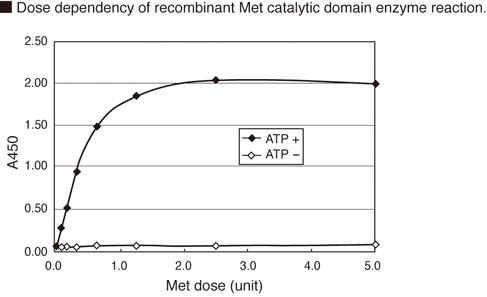CycLex Met Kinase Assay/Inhibitor Screening Kit
| Code | Size | Price |
|---|
| MBL-CY-1080 | 96 Assays | £631.00 |
Quantity:
Prices exclude any Taxes / VAT
Overview
Regulatory Status: RUO
Shipping:
4°C
Storage:
4°C. Please refer to datasheet for additional information
Images
Documents
Further Information
Applications:
Other - 1) Screening inhibitors or activators of recombinant catalytic domain of Met.
2) Detecting the effects of pharmacological agents on recombinant catalytic domain of Met.
Description:
The CycLex® Met Kinase Assay/Inhibitor Screening kit is designed to measure the activities of
recombinant catalytic domain of Met for the rapid and sensitive evaluation of inhibitors or activators.
The phosphotyrosine specific monoclonal antibody used in this assay kit specifically recognizes the
phosphotyrosine residue in the recombinant catalytic domain of Met, which is captured and activated by
recombinant ?Tyrosine kinase-binding module-1? (Cat. No. CY-2080) that has been immobilized on a
microtiter plate.
Gene IDs:
Rat: 17295
Immunogen Translated:
The MET protooncogene was discovered because of the ability of oncogenic Met to mediate
chemically induced transformation of a human osteogenic sarcoma cell line (1). This receptor tyrosine
kinase is synthesized as a single-chain precursor, which undergoes intracellular proteolytic cleavage at a
basic amino acid site, yielding a disulfide-linked heterodimer. Its C-terminal, intracellular region
contains a multifunctional docking site that binds to various signaling molecules.
The ligand of the Met receptor is HGF/scatter factor, known to stimulate invasive growth of epithelial
cells (2). It is a multifunctional factor affecting a number of cell targets including epithelium,
endothelium, myoblasts, spinal motor neurons, and hematopoietic cells. Signaling pathways activated by
the HGF-Met interaction mediate cell adhesion and motility. These cellular phenotypes, coupled to
tightly regulated changes in cell growth, morphology, and survival, define a general pattern of invasive
growth that occurs widely in normal development.
In addition, Met is involved in malignant cell transformation. Increased Met expression has been
found in a significant percentage of human cancers and is amplified during the transition between
primary tumors and metastasis. Point mutations in MET have been identified in hereditary and sporadic
papillary renal carcinomas (3?5), hepatocellular and gastric carcinomas (6, 7), and head and neck squamous
carcinomas (8). Numerous experimental and clinical data indicate a particular role of HGF and Met in
tumor invasive growth, a stage of tumor progression leading to metastases. Dysregulation of Met activity
in cells is thought to be a key event underlying tumor metastasis, and indeed, Met overexpression and
hyperactivation are reported to correlate with metastatic ability of the tumor cells (9).
Measurement Range:
Microplate, 10X Wash Buffer, Kinase Buffer, 20X ATP HRP conjugated Detection Antibody Substrate Reagent, Stop Solution
Target:
Met
References
1. Cooper, C.S., et al. Molecular cloning of a new transforming gene from a chemically transformed
human cell line. Nature. 311:29?33, 1984
2. Bottaro, D.P., et al. Identification of the hepatocyte growth factor receptor as the c-met
proto-oncogene product. Science. 251:802?804, 1991
3. Schmidt, L., et al. Germline and somatic mutations in the tyrosine kinase domain of the MET
proto-oncogene in papillary renal carcinomas. Nat. Genet. 16:68?73, 1997
4. Schmidt, L., et al. Novel mutations of the MET proto-oncogene in papillary renal carcinomas.
Oncogene. 18:2343?2350, 1999
5. Olivero, M., et al. Novel mutation in the ATP-binding site of the MET oncogene tyrosine kinase in a
HPRCC family. Int. J. Cancer.82:640?643, 1999
6. Park, W.S., et al. Somatic mutations in the kinase domain of the Met/hepatocyte growth factor
receptor gene in childhood hepatocellular carcinomas. Cancer Res. 59:307?310, 1999
7. Lee, J.H., et al. A novel germ line juxtamembrane Met mutation in human gastric cancer. Oncogene.
19:4947?4953, 2000
8. Di Renzo, M.F., et al. Somatic mutations of the MET oncogene are selected during metastatic spread
of human HNSC carcinomas. Oncogene. 19:1547?1555, 2000
9. Comoglio, P.M., and Trusolino, L. Invasive growth: from development to metastasis. J. Clin. Invest.
109:857?862, 2002




